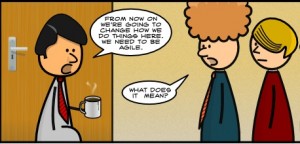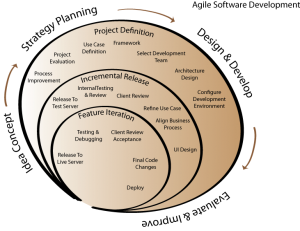 Much has been said about agile development for technology and web projects from a technical point of view, but I want to give you a perspective from a marketing point of view.
Much has been said about agile development for technology and web projects from a technical point of view, but I want to give you a perspective from a marketing point of view.
I’ve been a client commissioning digital projects as well as a consultant and supplier working with clients to deliver online projects. No matter how many websites I’ve been a part of building or online advertising campaigns I’ve sent to market, it’s very difficult to plan for every scenario that will eventuate and estimate the time and effort required to deliver the finish product.
Sometimes its simply human error
Of course there is an element of human error – miscalculating effort, trying something new and not knowing the implications, sometimes simply omitting an element that should have been planned. There is also changes made to the scope of work planned by the client. New ideas that have come up (often better ideas than what was already scoped and costed), a change that has come down from above, an internal breakdown of communication or sometimes simply a process or technical limitation when integrating the project with other departments or third party systems.
Agile development is specifically designed to take these types of changes, set ways and re-thinks into account. From my understanding, agile web development is about working in the “present” and managing the current situation, not being too rigid and sticking doggedly to the plan, adjusting accordingly to the new environment and new and better ideas. 
But the problem with this for the client, is that their budget doesn’t always extend to these “new ideas” or new ways of implementing the plan. And we can’t have everything. We can’t have the agile development that allows us to go with the flow and count nothing out, and deliver a project on time and on budget.
I’m not saying that as a supplier clients need an unlimited budget and scope of works and estimates mean nothing,they do. But we need to build in a 20% buffer of time (deadline) and budget if we are out allow for a change in the solution that is developed, mid stream. In some instances these segways and new ideas lead to cost savings, but. Given the human error element in planning, I think you’ll all agree that this doesn’t happen very often. Especially when you’re on the cutting edge of an industry, creating new products and using new technology that we’re all learning as we go.
Digital channels that are easier to estimate – tried and tested
Having said that, when it comes to email marketing and the infrastructure that is implemented to support it, I have been able to deliver projects on time, as planned and in budget. Sometimes wrangling the data and getting the databases into a healthy format, can be a challenge (depending how recent the information is, what format the data has been housed and what new segmented form you want it to take).
A standard affiliate marketing campaign or display banner ad is also pretty easy to estimate but as soon as you start working with rich media ads where you’re pulling in live data or creating dynamic content based on input from a user, things can go wrong, but these channels have been tested for a decade now. Human error still creeps in with incorrect sizes and specifications or the wrong click tags inserted for ad servers .
Social media apps are fairly well structured as they tend to be standardised to competitions where a user needs to like page to enter a competition or subscribe to an email database.
Each of these channels are more mature in their industry and can be well planned and estimated for, from the development side, but you still can’t always forecast accurately the take up of the audience. The more past data you have about your customers or supporters and historic information makes for better forecasts but there are no guarantees.
Online user behaviour keeps changing
Your website, like your digital marketing channels, are a forever work in progress. You need to optimise the message and the content and the experience until you find out what works best for your audience. And then you keep testing because what works this week might not work in three months time. And what worked last year probably won’t work next year – because technology and how we behave online keeps changing.
What I’m trying to share is that that you can never plan for everything. We can try to build in a buffer for senior executives who see the product in its later stages and want to make a change. We can try to account for unexpected technical glitches (which usually the developer would always wear the cost for such issues) and e can try to plan for staff turnover or people getting sick or things just taking longer than expected (often the case with content and approvals), but then your budget look scary and inflated and we suppliers can be accused of adding too much cream on top.
Lets work together
In the world of web development where the industry and technology is changing at such a rapid pace, I can assure you that we’re trying to estimate costs and time frames as best we can. If you want a carbon copy of some work that has been done in the past, where there is nothing new and it’s basically an off the shelf project, you’ll get a very good estimate and everything should go to LAN. But if you want to build something custom, try something new and bold and develop an online experience that really delivers a unique experience for your users, then you’ll need to have trust in your development partner and go on the journey together. We are still learning every day and every project is different because every team and business is different.
